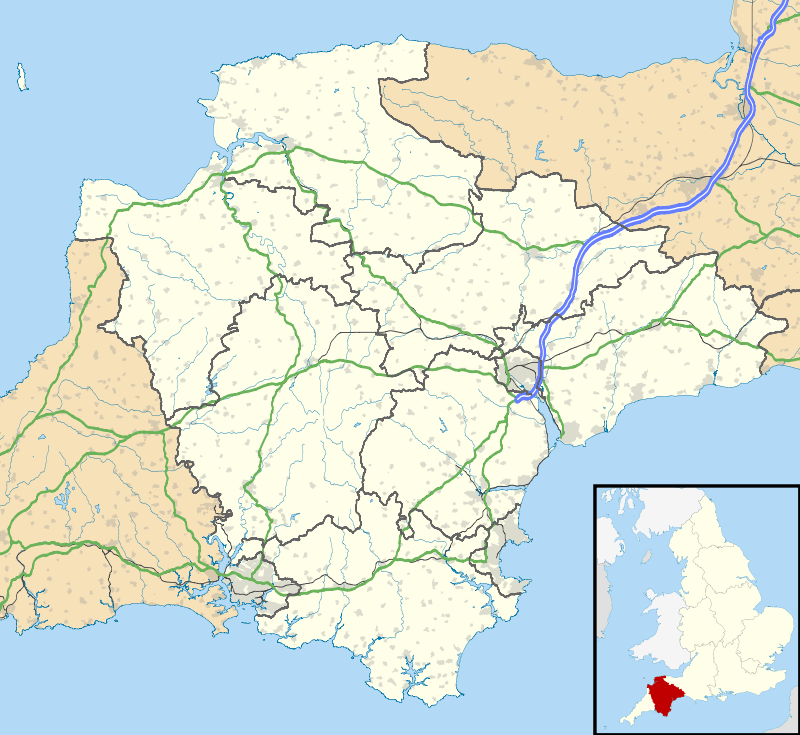Disappearance of Genette Tate
| Genette Tate | |
|---|---|
 A photograph of Genette Tate in her school uniform released at the time of her disappearance in August 1978. | |
| Born |
Genette Louise Tate 5 May 1965 |
| Disappeared |
19 August 1978 (age 13) Aylesbeare, Devon, England |
| Status | Missing for 40 years, 1 month and 28 days |
| Nationality | British |
| Height | 5 ft 0 in (1.52 m) |
| Parents |
|
The disappearance of Genette Tate is an unsolved missing person case dating from August 1978 in which a 13-year-old girl disappeared while delivering newspapers in Aylesbeare, Devon, England.
Despite extensive searches, Genette's body has not been found and the cause of her disappearance remains unknown. The case is Britain's longest missing persons inquiry[1] and has been described as a murder investigation by Devon and Cornwall Police.[2]
The disappearance of Genette Tate remains one of Britain's best known missing person cases.[3]
Early life
Genette Louise Tate was born in Taunton, Somerset on 5 May 1965. She was the only child born to John and Sheila Tate. At the time of Genette's birth, the Tate family resided in the Taunton suburb of Wedlands; they would briefly relocate to Cornwall before ultimately moving to Devon.[4]
Genette's parents separated when she was young; her father—with whom Genette resided—subsequently remarried, providing Genette with a stepmother, Violet, and a stepsister, Tania. She resided with her father at Barton Farm Cottage in the East Devon village of Aylesbeare. Despite her parents' separation, Genette maintained regular contact with her mother.[5]
Described as a "naturally shy" girl, Genette was just five feet in height, with short brown wavy hair, and has been described by her parents as being a somewhat "boyish" girl. She was known as "Ginny" to her family and friends, and attended Exmouth Comprehensive School, where she displayed a flair for mathematics and poetry. She is also known to have held a passion for animals.[6]
On 19 August 1978, Genette had been suntanned in complexion. She was wearing a white cotton T-shirt with her name embroidered in red letters upon the left shoulder, light brown trousers, and white plimsolls. Her father would also describe Genette as being somewhat physically immature for her age, although some of her friends would state Genette was becoming a young woman.[7]
Disappearance
Genette disappeared while delivering newspapers within sight of her home shortly after 15:30 (BST) on Saturday 19 August 1978. At approximately 3:28 p.m. on this date, two schoolfriends named Tracey Pratt and Margaret Heavey saw Genette walking along Within Road, pushing her bicycle. Genette—who had delivered 14 newspapers by this point—gave Tracey her mother's newspaper and briefly conversed with her friends as the trio ascended Within Road. At the top of the hill, Genette mounted her bicycle and rode ahead as her friends briefly paused to read an article within the newspaper Tracey had been given.[8][9]
Seven minutes later, and approximately 300 yards from where the two girls had last seen Genette, Tracey and Margaret discovered her bicycle lying in the centre of the road. Although investigators found no sign of a struggle at the scene, newspapers she had been scheduled to deliver were scattered across the tarmac.[10][11][n 1]

Investigation
Devon and Cornwall Police quickly discounted the possibility of Genette having run away as at the time of her disappearance she had no personal possessions beyond the clothing she was wearing. She had also left behind money she had been saving for an upcoming family holiday in her bedroom. Moreover, the money collected from the customers on her newspaper route was still in her purse upon her bike. The possibility of a traffic accident or hit-and-run was also ruled out since no tire marks were evident on the road and her bicycle was undamaged. Kidnapping was soon discounted as a possibility as no subsequent ransom demands were made.[12]
Eyewitnesses reported seeing a maroon Triumph (or vehicle of very similar appearance) in the lane at around the time of the disappearance, and police issued a photofit picture of a man they wanted to question in relation to the abduction. This individual was described as being a "very handsome man" in his early 20s with a pale complexion, short dark hair, who had been wearing a light-coloured shirt.[13]
Despite an extensive police investigation and a search of the surrounding countryside involving thousands of volunteers, Tate's disappearance remains unexplained. In 2002, DNA belonging to Genette Tate was found on one of her jumpers kept by her mother, which would allow her body to be identified if discovered. On the 25th anniversary of the case in 2003, Genette's parents John and Sheila both stated their belief that she is no longer alive. Police have amassed more than 20,000 cards in a filing system related to the case, which is stored at the Devon and Cornwall Police headquarters in Exeter.[14]
Following the conviction of serial killer Robert Black in October 2011 for the August 1981 murder of Jennifer Cardy, a spokesman for the Police Service of Northern Ireland commented that "There are striking similarities" between the the murder of Cardy and the disappearance of Genette Tate.[15] Black had already been questioned by Devon and Cornwall Police about the Tate case, but in August 2008 the Crown Prosecution Service (CPS) decided that there was insufficient evidence to charge him.[16][17] Devon and Cornwall Police were looking into the case again in June 2014 with the hope of prosecuting Black.[18]
John Tate, reflecting in 2008 as to ongoing setbacks and his determination to find his daughter.[19]
Aftermath
At the time of Black's death in January 2016, Devon and Cornwall Police were five weeks from submitting a file to the Crown Prosecution Service in which they sought a new decision on whether to prosecute him.[20] The file was submitted to the Crown Prosecution Service three months after Black's January 2016 death, although the Crown Prosecution Service stated that due to his death, they would not be making a posthumous decision on charging Black.[21]
On the eve of the 40th anniversary of his daughter's disappearance, John Tate made a further plea for information regarding his daughter's whereabouts. Explaining that his rapidly declining health means he can no longer make his annual trip from Manchester to Aylesbeare to mark the anniversary of his daughter's disappearance, Mr. Tate stated his final wishes are to give Genette a Christian burial and to subsequently be buried alongside his daughter.[22]
Mr. Tate further expounded that he and his former wife had never been shown any definitive proof Robert Black had been responsible for their daughter's abduction and murder.[23]
See also
Notes
- ↑ Genette would not typically have performed this newspaper round; she had only agreed to perform this delivery round for one week as the paper boy who performed this particular delivery round was on holiday
References
- ↑ "Scores Contact Genette Tate Hotline". Herald Scotland. 1 March 1997. Retrieved 14 October 2018.
- ↑ "Full Report: The Mystery of Genette Tate, 35 Years On". ITV News. 13 January 2016. Retrieved 13 October 2018.
- ↑ "The Disappearance of Genette Tate: The Full Story of the Missing Girl That Has Baffled Devon for 40 Years". Devon Live. 20 August 2018. Retrieved 12 October 2018.
- ↑ "Disturbing Letters Make Shock Claims Missing Genette Tate is Buried in Garden". Devon Live. 2 August 2017. Retrieved 13 October 2018.
- ↑ "Missing Girl: Police Check Unsolved 1969 File". The Guardian. 22 August 1978. Retrieved 13 October 2018.
- ↑ "Missing Girl: Police Check Unsolved 1969 File". The Guardian. 22 August 1978. Retrieved 13 October 2018.
- ↑ Greaves, Paul. "The Disappearance of Genette Tate" – via devonlive.co.uk.
- ↑ "Genette's parents' Devon pilgrimage". BBC News. 19 August 2003.
- ↑ "Britain's longest missing person inquiry - 20 years on". BBC News. 18 August 1998.
- ↑ "Genette's parents' Devon pilgrimage". BBC News. 19 August 2003.
- ↑ "Britain's longest missing person inquiry - 20 years on". BBC News. 18 August 1998.
- ↑ "Prime Suspect in Genette Tate's Disappearance Dies in Prison". ITV News. 13 January 2016. Retrieved 13 October 2018.
- ↑ Collier, Graham (1995). Ramed, Murdered and Buried in a Shallow Grave?. Killers. May 1995 issue. ISSN 9-771-35256-501-1 p. 48
- ↑ "Genette Tate Search 25 Years Old". BBC News. 19 August 2003.
- ↑ "Missing girl team probes Cardy case". Belfast Telegraph. 28 October 2011.
- ↑ "Prime suspect in 1978 murder of schoolgirl Genette Tate will not face charges". The Daily Telegraph. 18 August 2008.
- ↑ "Killer Robert Black's link to Genette Tate reviewed". BBC News. 27 October 2011.
- ↑ "Genette Tate: police in talks with hope of prosecuting Robert Black for murder". The Guardian. Press Association. 2 June 2014. Retrieved 12 January 2016.
- ↑ "Prime suspect in 1978 murder of schoolgirl Genette Tate Will Not Face Charges" – via telegraph.co.uk.
- ↑ "Robert Black case: Police were close to child murder charge". BBC News. 13 January 2016. Retrieved 14 January 2016.
- ↑ "Robert Black case: Police Were Close to Child Murder Charge". BBC News. 13 January 2016. Retrieved 12 October 2018.
- ↑ "Genette Tate's Father is on His Deathbed - and Has One Final Plea". Devon Live. 18 August 2018. Retrieved 13 October 2018.
- ↑ "Genette Tate's Father is on His Deathbed - and Has One Final Plea". Devon Live. 18 August 2018. Retrieved 13 October 2018.
Further reading
- O'Brien, Susan (2008). Criminal Investigations: Child Abduction and Kidnapping. New York: Chelsea House Publishers. ISBN 978-0-791-09403-7.
- Wyre, Ray; Tate, Tim; Richardson, Charmaine (2018). The Murder of Childhood: Inside the Mind of One of Britain's Most Notorious Child Murderers. Hampshire: Waterside Press. ISBN 978-1-909-97662-7.
External links
- 2003 BBC News interview with Devon and Cornwall Police officers regarding the investigation into the disappearance of Genette Tate
- 2011 BBC News interview with Genette Tate's father
- BBC archive footage pertaining to the disappearance of Genette Tate
- Contemporary Herald Express news article regarding the possibility of Robert Black being charged with Genette Tate's abduction and murder
- Express and Echo news article regarding the disappearance of Genette Tate (requires iTunes)
- Genette Tate at The Doe Network
- The Disappearance of Genette Tate: A website detailing the disappearance of Genette and ongoing efforts to discover the truth as to her fate